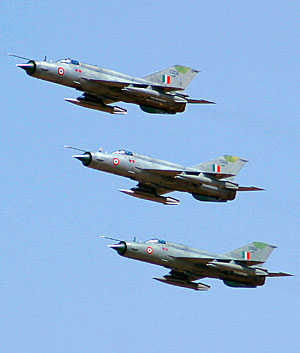INDIAN ARMED FORCES CHIEFS ON OUR RELENTLESS AND FOCUSED PUBLISHING EFFORTS

The insightful articles, inspiring narrations and analytical perspectives presented by the Editorial Team, establish an alluring connect with the reader. My compliments and best wishes to SP Guide Publications.

"Over the past 60 years, the growth of SP Guide Publications has mirrored the rising stature of Indian Navy. Its well-researched and informative magazines on Defence and Aerospace sector have served to shape an educated opinion of our military personnel, policy makers and the public alike. I wish SP's Publication team continued success, fair winds and following seas in all future endeavour!"

Since, its inception in 1964, SP Guide Publications has consistently demonstrated commitment to high-quality journalism in the aerospace and defence sectors, earning a well-deserved reputation as Asia's largest media house in this domain. I wish SP Guide Publications continued success in its pursuit of excellence.
Yet another MiG-21 crashes, pilot killed

NEWS
On August 2, a MiG-21 fighter aircraft crashed soon after taking off from Nal airfield in Rajasthan’s Bikaner district killing the pilot. “The pilot ejected but died due to injuries sustained by him,” a defence spokesperson said. The MiG-21 ‘Type-96’ aircraft was on a routine sortie and crashed near the airfield, which is about 15 km from Bikaner city, he said. This is the second crash of a MiG series fighter aircraft this year. On February 4, an IAF MiG-21 ‘Bison’ fighter plane had crashed apparently due to an engine problem while on a routine sortie in Madhya Pradesh’s Sheopur district but the pilot had ejected safely.
VIEWS
As only 48 hours had elapsed at the time of writing since the tragic air accident occurred at the IAF’s Nal Air Base, there was no clarity as to what happened which led to loss of life of a young pilot in the desert sands of western Rajasthan. While a court of inquiry (COI) has been ordered, the IAF is understandably tight-lipped about the details of the accident at this stage. What has been revealed by the defence correspondents indicate that the pilot was on a routine training sortie, perhaps part of the Ops U/T syllabus required to be completed for the newly inducted pilots to become ‘Fully Ops’ on type in the IAF’s operational squadrons. Preliminary findings as reported in the media however lead one to believe that the accident occurred due to certain complications during the landing phase of the sortie, which led the pilot to abandon the aircraft at low level. The ejection however was unsuccessful which ultimately resulted in fatal injuries to the pilot.
There could be a host of reasons which might have led the pilot to take a conscious decision to eject and while it is not intended to indulge in premature analysis, some probabilities could however be discussed. The accident occurred during broad daylight i.e. at 11:30 a.m. Spatial-disorientation—one of the major causes involving fighter accidents— could reasonably be ruled out. The other most probable cause could be loss of thrust/flame out due to technical malfunction of the engine/bird strike. Even though Type 96 (MiG-21 M) involved in the accident has a comparatively smaller radome, a large bird strike can still choke the intake to cause engine flameout. As the preliminary reports suggest, the pilot was approaching the runway at Nal for a landing and therefore the possibility of a bird hit cannot be ruled out. Losing the sole source of power in the single-engine MiG-21 aircraft; that too at a low height and low speed (in landing phase of the flight), leaves few options for the pilot to take corrective emergency actions except to eject as soon as possible.
Operational requirements demand the combat jet fighters to be mean machines where performance concerns override safety in case of a conflict between the two. That is why fighter aircraft are inevitably equipped with ejection seats to enable the pilot to safely leave a stricken machine under extreme circumstances. That brings to the fore the question of ejection seats and their capabilities. Whatever may be the safety concerns of Russian aircraft especially of older vintage, nobody can fault their ejection seat technology which has always been on par or even better than the ‘west’. For example, Russians were the first to invent rocket-assisted flight crew escape systems. MiG-21M may be old vintage but it is fitted with either zero (altitude)/zero (speed) or zero-90 kmph ejection seat, greatly increasing the ejection envelope. But there is a caveat as these, especially the ‘zero-altitude’ capability can get seriously eroded in case of an aircraft in descent.





